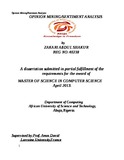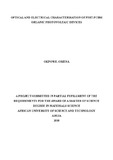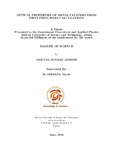Browsing by Title
Now showing items 3018-3037 of 4806
-
Online Learning of Non-stationary Sequences
(2003-06-12)We consider an online learning scenario in which the learner can make predictions on the basis of a fixed set of experts. The performance of each expert may change over time in a manner unknown to the learner. We formulate ...
-
Online Learning of Non-stationary Sequences
(2005-11-17)We consider an online learning scenario in which the learner can make predictions on the basis of a fixed set of experts. We derive upper and lower relative loss bounds for a class of universal learning algorithms involving ...
-
ONTIC: A Knowledge Representation System for Mathematics
(1987-07-01)Ontic is an interactive system for developing and verifying mathematics. Ontic's verification mechanism is capable of automatically finding and applying information from a library containing hundreds of mathematical ...
-
Oort: User-Centric Cloud Storage with Global Queries
(2016-12-08)In principle, the web should provide the perfect stage for user-generated content, allowing users to share their data seamlessly with other users across services and applications. In practice, the web fragments a user's ...
-
An open source model for teaching environments incorporating wireless devices
(University of Cape TownFaculty of ScienceDepartment of Computer Science, 2007)Attempts have been made at bridging the digital divide in schools using desktop PC systems without much success. As a result many computer laboratories sit empty. There are many reasons for these failures. Often there are ...
-
Open Systems
(1982-12-01)This paper describes some problems and opportunities associated with conceptual modeling for the kind of "open systems" we foresee must and will be increasingly recognized as a central line of computer system development. ...
-
OpenTuner: An Extensible Framework for Program Autotuning
(2013-11-01)Program autotuning has been shown to achieve better or more portable performance in a number of domains. However, autotuners themselves are rarely portable between projects, for a number of reasons: using a domain-informed ...
-
An Operating Environment for the Jellybean Machine
(1988-05-01)The Jellybean Machine is a scalable MIMD concurrent processor consisting of special purpose RISC processors loosely coupled into a low latency network. I have developed an operating system to provide the supportive ...
-
An Operating System for Multicore and Clouds: Mechanisms and Implementation
(2010-02-08)Cloud computers and multicore processors are two emerging classes of computational hardware that have the potential to provide unprecedented compute capacity to the average user. In order for the user to effectively harness ...
-
Operating the Lisp Machine
(MIT Artificial Intelligence Laboratory, 1981-04)This document is a draft copy of a portion of the Lisp Machine window system manual. It is being published in this form now to make it available, since the complete window system manual is unlikely to be finished in the ...
-
Operation of a Semantic Question-Answering System
(1963-11-01)A computer program has been written in the LISP programming language which accepts information and answers questions presented to it in a restricted form of natural English language. The program achieves its effects by ...
-
Operator Theory and Analytic Functions
(AUST, 2019-06-05)The theory of analytic functions plays a central role in operator theory. It has been a source of methods, examples and problems, and has led to numerous important results. Weighted shifts (which we shall see in the sequel) ...
-
Opinion Mining/Sentiment Analysis
(2013-04-15)There has been tremendous growth in the amount of user generated content on the Internet. This is due to rise in social networks and the embrace of web 2.0 or technologies. The Internet is no longer a place for consumption ...
-
OpLog: a library for scaling update-heavy data structures
(2014-09-16)Existing techniques (e.g., RCU) can achieve good multi-core scaling for read-mostly data, but for update-heavy data structures only special-purpose techniques exist. This paper presents OpLog, a general-purpose library ...
-
-
Optical conductivity with holographic lattices
(Journal of High Energy Physics, 2012-08-06)
-
Optical Flow From 1D Correlation: Application to a Simple Time-To-Crash Detector
(1993-10-01)In the first part of this paper we show that a new technique exploiting 1D correlation of 2D or even 1D patches between successive frames may be sufficient to compute a satisfactory estimation of the optical flow field. ...
-
The Optical Flow of Planar Surfaces
(1985-12-01)The human visual system can recover the 3D shape of moving objects on the basis of motion information alone. Computational studies of this capacity have considered primarily non-planar rigid objects. With respect to ...
-
Optical micrographs of carbon nanotube suspensions
(2008-03-27)
-
Optical Properties of Metal Clusters from First Principles Calculations
(2016-06-17)Ground State structures of neutral Copper clusters Cu N =3−6 were generated and optimised within the framework of the Density Functional Theory (DFT) using Generalised Gradient Approximation (GGA) and ultrasoft pseudopotential. ...



